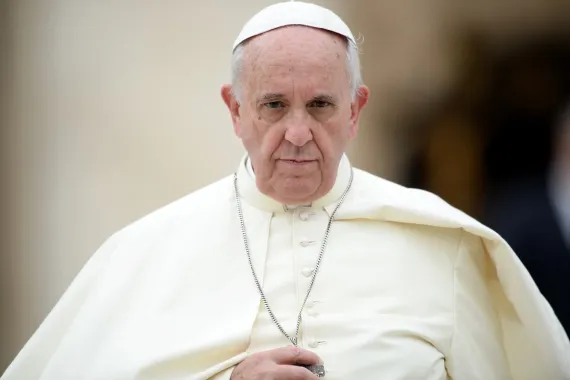The first Latin American Pope, Francis, died on Easter Monday morning at the age of 88, ending a papacy that changed the look and tone of the Roman Catholic Church in modern times.
The Vatican confirmed his death in a solemn video statement released the same day.
LEADERSHIP recalls that the pope had been battling health issues for several years and had recently suffered a severe case of double pneumonia.
Despite his frailty, Francis continued to represent moral strength, humility, and deep faith, even making two public appearances after being discharged from the hospital.
As the world grieves his passing, hereunder are key facts that shed light on his remarkable life:
1. His Background
Pope Francis was born Jorge Mario Bergoglio on December 17, 1936, in the Flores area of Buenos Aires, Argentina. He was the first of five children in a strongly religious family with Italian immigrant roots.
His father, Mario José Bergoglio, escaped Mussolini’s Italy in 1929, while his mother, Regina María Sívori, was born in Argentina to Italian parents. Their faith and traditions profoundly shaped Jorge’s early years.
2. Early Education
Building on these early influences, he studied under the Salesians of Don Bosco, a religious group known for teaching and discipline. Their values would later guide his emphasis on education and youth.
Before entering the priesthood, he earned a diploma in Chemistry and worked in a food lab.
3. Work Before Priesthood
Alongside his studies, Francis took on ordinary jobs such as a nightclub bouncer and a janitor.
4. Health Battles
His resilience was tested early in life when, at 21, he had part of his lung removed due to a serious infection, possibly pneumonia or a lung cyst. Still, he remained active and committed to his calling.
He later faced sciatica, a painful nerve condition that affected his mobility, as well as minor heart issues like an irregular heartbeat.
In his later years, joint problems and a torn knee ligament led him to use a wheelchair more often. He also underwent colon surgery in 2021 for diverticulitis, a condition common in older adults.
In his final years, recurring respiratory infections, including bronchitis and pneumonia, ultimately contributed to his death in 2025.
5. His Journey to Priesthood
During a moment of deep reflection in confession, Francis felt called to the priesthood—an experience that forever altered his life path.
He joined the Jesuits, a Catholic order known for deep intellectual thought and a focus on justice. His Jesuit formation played a significant role in how he led and served.
He pursued higher studies in philosophy and theology, and later taught literature and psychology in Jesuit institutions, demonstrating a balance of intellectual insight and pastoral care.
He was ordained a priest on December 13, 1969, beginning a lifelong journey of ministry and service.
6. His Works in Ministry
Just a few years later, at 36, he became the Jesuit leader in Argentina during political unrest. He navigated this tense period with courage, though not without facing criticism.
He later made his final Jesuit vows, pledging obedience to the pope—a promise that would come full circle when he became pontiff himself.
In 1973, a trip to the Holy Land was disrupted by the Yom Kippur War, an early experience of global conflict that foreshadowed the complex world challenges he would face as pope.
He also led the Jesuit seminary at San Miguel, mentoring future priests and shaping his pastoral style.
To broaden his perspective, he studied abroad and explored the works of notable theologians like Romano Guardini.
However, tensions over Church direction and liberation theology led to some isolation from his peers, a season that helped refine his beliefs and leadership approach.
7. Episcopal Ministry as Bishop and Archbishop
In 1992, Pope John Paul II appointed him as auxiliary bishop of Buenos Aires.
He later became archbishop of the same city, where he was widely recognized for his humility and down-to-earth lifestyle. He chose to ride the bus, live in a small apartment, and cook his meals, habits he carried to Rome as pope.
8. His Journey as Cardinal
In 2001, Pope John Paul II elevated him to the rank of cardinal, giving him a larger platform to influence the Church globally.
During Argentina’s economic crisis, he stood firmly with the poor, providing spiritual guidance and moral leadership.
Then, following Pope Benedict XVI’s surprising resignation, Cardinal Bergoglio was elected pope, a choice that surprised many outside Latin America.
9. The Name “Francis”
Upon his election, he made history by choosing the name Francis—the first pope ever to do so—in honour of Saint Francis of Assisi. This powerful gesture highlighted his commitment to peace, humility, and care for the poor, and it set the tone for the rest of his papacy.
10. His Works as Pope
As Pope, Francis embarked on significant reforms within the Vatican, aiming for better transparency, especially in financial matters and administration.
In 2015, he released Laudato Si’, a groundbreaking encyclical framing climate change as a moral and spiritual issue, calling on humanity to protect “our common home.”
Throughout his papacy, he focused on mercy rather than judgment. He opened doors for deeper conversations around family, sexuality, and the inclusion of those often sidelined by the Church, such as divorced Catholics and LGBTQ individuals.
He also made a historic apology for the Church’s role in the mistreatment of Indigenous children in Canada’s residential schools, calling it a form of “cultural genocide.”
11. His Death
After more than a decade of transformative leadership, Pope Francis passed away in Vatican City on April 21, 2025, at 88.
His death came just one day after a heartfelt appearance on Easter Sunday





